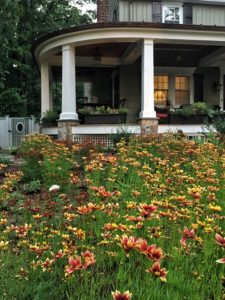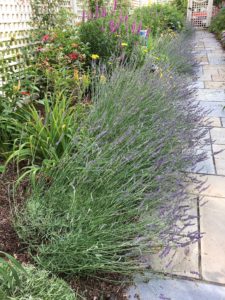Hello, fellow lovers of all things green,
At last, the spring garden clean up. It’s fun to tidy things up, picking up branches and sticks and cutting down the ornamental grasses left dry over winter to a few inches above the ground. Hedge trimmers or chainsaws (for those braver than me) are perfect for cutting tall grass. Then, remove the dry plant debris left from last season to provide a habitat for insects and food for wildlife. The woody perennials or semi-shrubs such as Butterfly Bush, Asters, and Lavender are the most confusing to folks on how to prune. So, here’s the skinny:

Ann DeCamp
http://www.anndecamp.com/
How to Rejuvenate Woody Perennials
It is best to rejuvenate Butterfly Bush (Buddleia davidii) each year by cutting them to six to eight inches above ground level. Better yet, replace them with native plants that are far more beneficial to pollinators, including butterflies. For example, there’s Summersweet, aka Sweet Pepperbush (Clethra alnifolia), New Jersey Tea (Ceanothus americanus), and Buttonbush (Cephalanthus occidentalis) for the shadier spots.
Other woody perennials include the late-season glory of New England Aster (Symphyotrichum novae-angliae), whose deadwood should be removed in early spring. For hydrangeas and clematis, wait until new growth emerges before pruning back the deadwood. Be patient; this year may be an anomaly of sprouting starting later due to the single digits endured over winter.

Ann DeCamp’s lovely garden. Garden Design by Mary Stone and Marty Carson
It’s a joy to revisit projects from long ago designed with my colleague Marty Carson, such as Ann’s garden in Scotch Plains, NJ, whose lovely landscape we installed several years ago. Ann is an avid gardener and an extraordinary photographer who kindly shared her photos.
Ann loves Lavender, harvesting the bounty of blooms as potpourri. Pruning lavender can be tricky and take some finesse, just as growing it does, unless you have well-drained soil, full sun, and good airflow around the plants. It’s best to prune them yearly to improve their vigor and extend their life.

Garden Design by Mary Stone and Marty Carson
How to Prune English Lavender
The time to prune Lavender is after the bloom or up to mid-spring without foregoing this year’s blooms. While at it, you can use the cuttings to propagate new plants. Dip the ends into a rooting hormone and start them in a moist, sandy potting mix.
English Lavender (Lavandula angustifolia) is the most common and toughest Lavender. It’s ideal as a low hedge around an herb garden. To keep it compact, cut English Lavender by two-thirds or three nodes above the bare wood in mid-August, allowing new shoots to harden off before winter. Then, tidy them up with light pruning in April.
When tending to plants that have not been pruned each year and have become overly woody, you’ll need to phase in pruning to rejuvenate the plant. Trim each branch by a third or a half, never down to the brown wood, ensuring viable leaves remain on the plant. Thin out the oldest stems to encourage new growth. Then, prune lightly again in the fall to shape the plant.
How to Prune Phenomenal Lavender

‘Phenomenal’ Lavender (Lavandula x intermedia)
There’s a separate way to prune the later-blooming Phenomenal Lavender (Lavandula x intermedia). This comparatively new introduction is exceptionally tolerant of heat, humidity, and harsh winters. Its longer flowering stems are lovely and flow with the wind. However, they are less tough and cannot be pruned to the leafless, bare wood. Phenomenal Lavender is best cut to the mound of foliage below its spent flowering stems in late August.
Whichever Lavender you have, remember it won’t rejuvenate on old wood. So, if that’s what you are dealing with, it’s time to replace your deadwood with something new. One could say the same is true in our Garden of Life. Happy Spring Cleaning! Happy New Beginnings.
Garden dilemmas? AskMaryStone@gmail.com and your favorite Podcast App.
Other helpful tips in Reasons to Prune
There’s more to the story in the Garden Dilemmas Podcast:
Another story featuring Marty Carson that you’ll enjoy: White Flowers in Gardens Glow



I just read your post on trimming lavender. You gave good, detailed instructions that are easy to visualize and execute. I am delighted I stumbled on your site, as I searched for how to rejuvenate way overgrown and poorly managed shrubbery.
Thank you for being so willing to share your knowledge and experience.
Hi Judy, You are so welcome. How kind of you to write. Thank you for lifting my heart. Happy gardening, Mary Stone